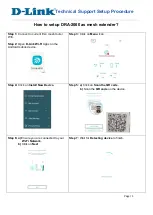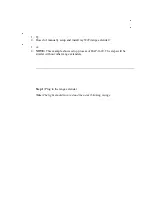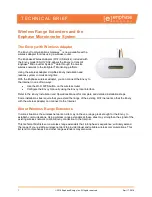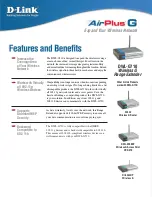
⦁
Ensure for Grade 3 or 4 compliant systems, the minimum PIN length is set for 6 digits.
⦁
To comply with EN 50131-1 Engineer access must first be authorized by a user, therefore Installer codes will
only be accepted when the system is unset. If additional restriction is required then Engineer access may be
time limited to the first 30 seconds after the system is unset.
⦁
Reporting delay –Violation off the entry path during the entry delay countdown will trigger a warning alarm.
The warning alarm should not cause a main alarm signal and is not reported at this time. It can be signaled
locally, visually and or by internal siren type. If the area is not disarmed within 30 seconds, the entry delay has
expired or another instant input is violated, the main alarm will be triggered and reported.
⦁
To comply with EN 50131-1 neither Internals Only on Part Set Input Alarm nor Internals Only on Part Set
Tamper Alarm should be selected.
⦁
To comply with EN 50131-1 Single Button Setting should not be selected.
⦁
To comply with EN 50131-1 only one battery can be connected and monitored per system. If more capacity is
required a single larger battery must be used.
⦁
For Security Grade 4 installations, two forms of reporting are required. This can be satisfied using the onboard
2400bps modem included with the modem controller model, or through the incorporation of the PRT-4G-USB
cellular modem module into the installation with the non-modem controller model.
Anti Masking
To comply with EN 50131-1 Grade 3 or 4 for Anti Masking, detectors with a separate or independent mask signal
should be used and the mask output should be connected to another input.
I.e. Use 2 inputs per detector. One input for alarm/tamper and one input for masking.
To comply with EN 50131-1:
⦁
Do not fit more than 10 unpowered detectors per input,
⦁
Do not fit more than one non-latching powered detector per input,
⦁
Do not mix unpowered detectors and non-latching powered detectors on an input.
To comply with EN 50131-1 the Entry Timer should not be programmed to more than 45 seconds.
To comply with EN 50131-1 the Bell Cut-Off Time should be programmed between 02 and 15 minutes.
EN 50131-1 requires that detector activation LEDs shall only be enabled during Walk Test. This is most conveniently
achieved by using detectors with a Remote LED Disable input.
To comply with EN 50131-1, EN 60839-11 Security Grade 4 and AS/NZS2201.1 class 4&5 Vibration Detection for
PreTamper Alarm, protection is provided by a DSC SS-102 Shockgard Seismic vibration sensor mounted within the
system enclosure. Alarm output is provided by a pair of non-latching, N.C. (normally closed) relay contacts,
opening for a minimum of 1 second on detection of an alarm connected in series with the 24Hr tamper input (TP)
on the PSU (or any other system input designated/programmed as a 24Hr Tamper Alarm).
This relay is normally energized to give fail-safe operation in the event of a power loss. Indication of detection is
provided by a LED situated on the front cover. The vibration sensor is fully protected from tampering by a N.C.
micro switch operated by removal of the cover.
Enclosure EN-DIN-24 has been tested and certified to EN50131.
By design, the enclosures for all Integrated Control Technology products, EN-DIN-11, EN-DIN-12 and EN-DIN-24-
ATTACK, comply with the EN 50131 standards. Tamper protection against removal of the cover as well as removal
from mounting is provided by tamper switch.
Warning: Enclosures supplied by 3rd parties may not be EN50131-compliant, and should not be claimed as
such.
PRT-IO84-DIN | Protege DIN Rail 8 Input 4 Output Expander | Installation Manual
22






































